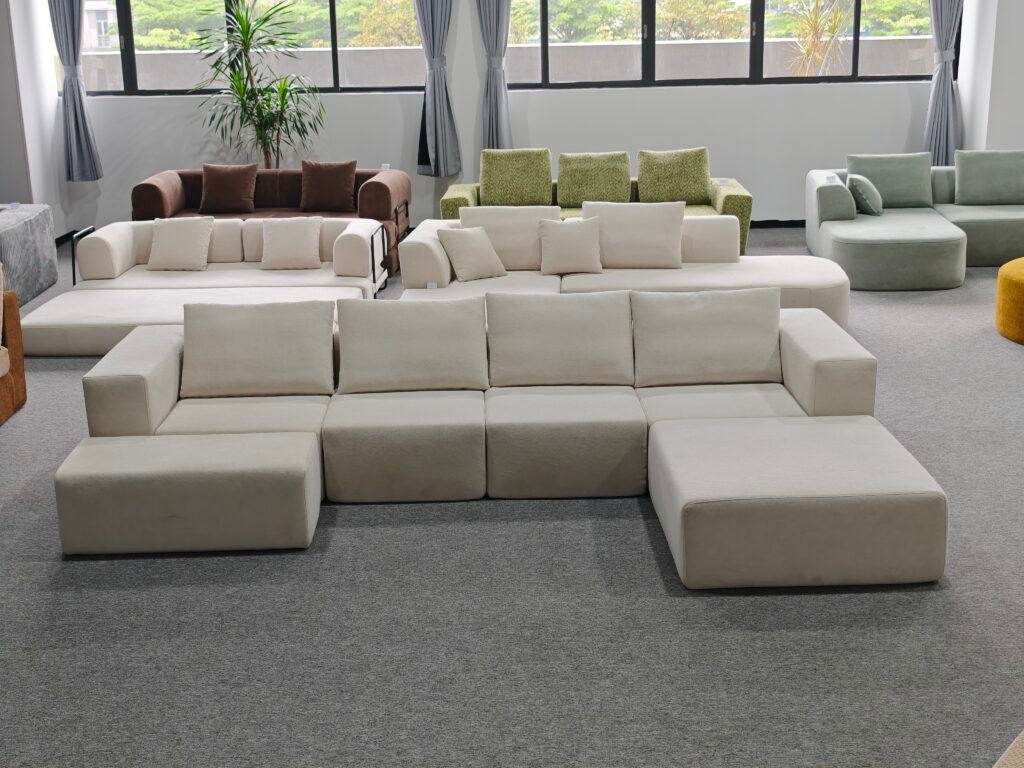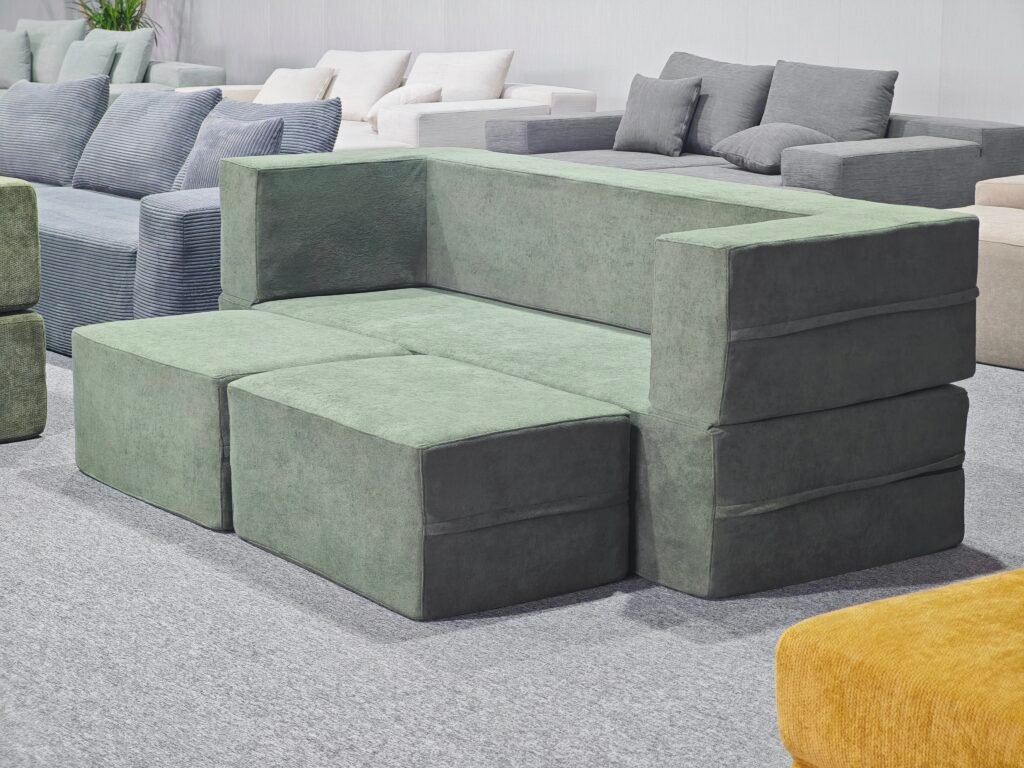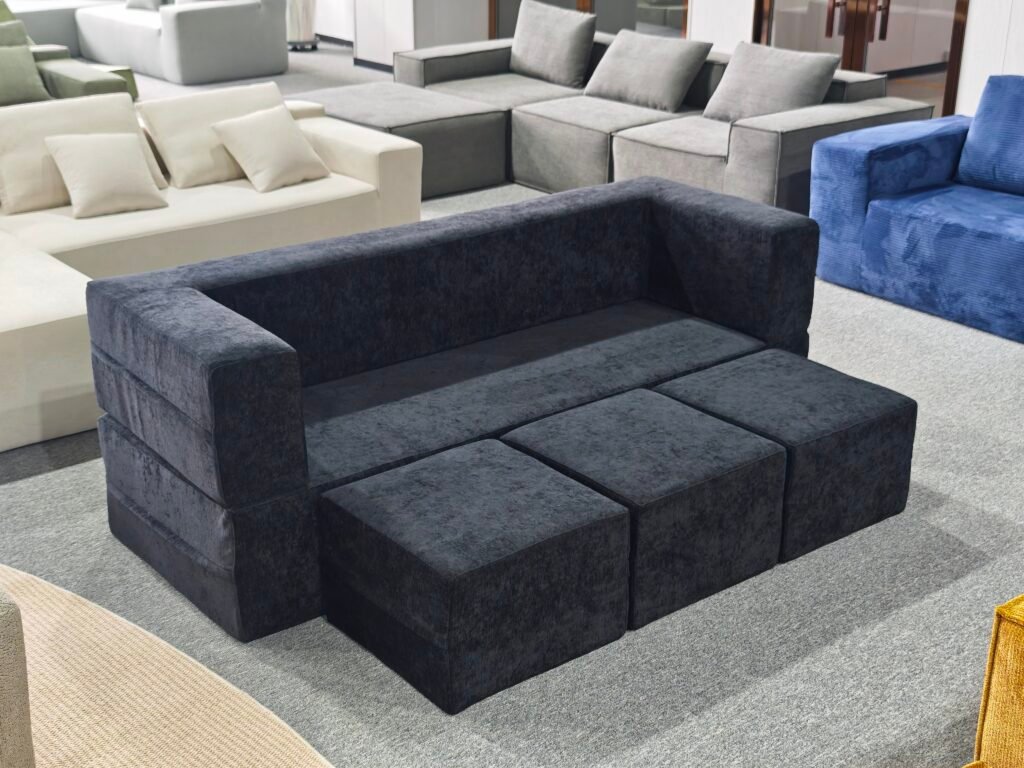Choosing the right color for compressed sofa covers in light-sensitive rooms is far from a simple decorative decision; it’s a crucial factor that influences comfort, durability, and atmosphere. With light-sensitive spaces—such as sun-drenched living rooms, home offices with computer screens, or any room where ambient brightness needs careful balance—the color you select can either enhance the experience or become a persistent source of discomfort.
This comprehensive guide, based on the expertise of a leading compressed sofa factory and drawing on interior design psychology, material science, and current trends, provides all the information needed to make the ideal choice for compressed sofa covers in spaces affected by dynamic light.


Understanding Compressed Sofa Covers
Compressed sofa covers are designed to perfectly fit modular sofas that arrive in a compressed, space-saving form. These covers are typically crafted to be easy to handle, durable, and tailored to recapture the sofa’s original stylish appearance once the furniture is unpacked and assembled. They must withstand frequent use and washing, all while preserving their color integrity and textural appeal—especially in environments where sunlight or strong artificial lighting is a constant.
Light Sensitivity and Its Impact on Room Design
Light-sensitive rooms occur for many reasons:
- Some spaces are awash with direct natural light, particularly those with large or southern-facing windows.
- Others may rely on soft, diffused lighting to reduce eye strain, especially if they’re used as home theaters or study zones.
- High-rise apartments or rooms with skylights can experience extreme light shifts throughout the day.
- As interior design trends favor open-plan spaces with more glass and fewer partitions, the need to tailor furniture (especially compressed sofas) to specific lighting conditions only grows.
The interplay between light and furniture color is fundamental: the way fabrics reflect, absorb, and interact with ambient light shapes not just the look but also the function of a room.
The Science and Psychology of Color in Light-Sensitive Environments
Light alters our perception of color, which in turn affects mood and comfort. In a light-sensitive room, where brightness can fluctuate or require moderation, these changes are exaggerated:
- Reflection and Absorption: Light-colored fabrics bounce light back, sometimes excessively, making a space feel larger but potentially glare-prone. Darker hues absorb light, reducing glare but possibly making the room feel smaller or warmer.
- Fade Resistance: Exposure to strong sunlight speeds up color fading, especially in bold or saturated fabrics that lack UV protection. Softer, earthier tones often fare better over time.
- Mood Impact: Colors have a psychological weight—blues and greens calm the mind, while reds and yellows can energize or overstimulate. In sensitive rooms, these effects can either soothe or create strain.
Core Principles: Choosing Sofa Cover Colors for Light-Sensitive Rooms
When advising customers on compressed sofa cover colors for these specialized environments, the following principles are paramount:
- Balance Light Management and Comfort: Pick colors that neither over-reflect nor over-absorb light. Too much reflection can be harsh, while excessive absorption can dull the space.
- Prioritize Fabric Quality: Opt for UV-resistant treatments, colorfast dyes, and tightly woven fabrics, as they better withstand fluctuating lighting and reduce fading.
- Harmonize with Room Purpose: For relaxation areas, lean toward calming hues. For high-activity, family-friendly zones, opt for practical colors that disguise stains and wear but aren’t too dark.
Comprehensive Color Analysis for Compressed Sofa Covers
Below is an expanded discussion of color families, their suitability for light-sensitive environments, psychological effects, and practical maintenance implications:
Neutral Colors
Examples: Beige, light gray, cream, soft white
Neutral tones stand out as the safest and most versatile options for compressed sofa covers in variable lighting. They blend effortlessly with other furnishings, reflect enough light to keep dimmer spaces cheerful, but are usually not so stark as to cause glare—especially if the texture is soft or matte.
- Advantages: Easy to accessorize, timeless, visually expands space. They reflect moderate light, which helps rooms feel welcoming.
- Considerations: May need regular cleaning, as lighter shades can reveal stains.
- Psychological effect: Calm, restful, non-distracting, can act as visual “air” in a cluttered space.
Earth Tones
Examples: Olive green, brown, taupe, terracotta
Earthy colors absorb more light, which can help diffuse direct sun and reduce eye strain in light-filled rooms. Their natural grounding appeal provides cozy warmth, making them ideal for living rooms and dens.
- Advantages: Resist fading better than brights, less likely to show dirt, create an inviting, casual atmosphere.
- Considerations: Darker earth shades can make small spaces feel more intimate—sometimes at the expense of perceived size.
- Psychological effect: Comforting, stable, evokes nature and serenity.


Pastel Shades
Examples: Soft blue, blush pink, mint green, lavender
Pastels diffuse light gracefully and foster a calming atmosphere, making them a compelling choice for reading nooks, bedrooms, or anywhere a soft touch is desired. However, they need UV-resistant fabric, as paler colors fade quickly under unfiltered sunlight.
- Advantages: Convey tranquility, can brighten subdued spaces, gentle on the eyes.
- Considerations: Without good UV protection, may fade unevenly or become washed out.
- Psychological effect: Peaceful, nurturing, perfect for spaces of relaxation.
Muted Tones
Examples: Dusty blue, warm gray, sage green, ochre
Subtle, desaturated colors fall between neutrals and earth tones. They often strike an ideal balance, absorbing just enough light to cut glare without sacrificing openness. They are fashionably understated, pairing well with wood, metal, or glass accent pieces.
- Advantages: Elegant, don’t overpower a room, easy to pair with various decor styles.
- Considerations: Must ensure colorfastness, as subtle hues can look dingy if they fade.
- Psychological effect: Sophisticated, modern, stabilizing.
Warm Neutrals
Examples: Champagne, warm tan, honey, sand
Warm neutrals add a sense of gentle energy and can prevent an overly sunny room from feeling too cold or clinical. They soften natural daylight, help hide small spills or wear, and are inviting in open-plan living areas.
- Advantages: Adds warmth without heaviness, looks clean but not sterile.
- Considerations: Needs to complement flooring and wall tones for best effect.
- Psychological effect: Welcoming, cozy, subtly luxurious.
Darker Hues (Use with Caution)
Examples: Charcoal, navy, deep green
While dark colors can be dramatic and show fewer stains, they do absorb significant light and are best used as accents or in very large, brightly lit areas. They can also become heat traps in rooms with direct sun and are more prone to uneven fading in harsh light.
Practical Color Comparison Table
To provide a detailed, at-a-glance summary, here’s a practical comparative table:
| Feature/Color | Beige/Cream | Light Gray | Olive Green | Soft Blue | Blush Pink | Warm Tan | Brown |
|---|---|---|---|---|---|---|---|
| Light Reflection | High | Moderate | Low | Moderate | Moderate | Moderate | Low |
| Fade Resistance | Medium | Medium | High | Medium | Low | High | High |
| Psychological Feel | Calm/Neutral | Calm | Warm/Natural | Soothing | Soothing | Warm | Warm |
| Stain Visibility | Medium | Medium | Low | Medium | High | Low | Low |
| Versatility | High | High | Medium | Medium | Medium | Medium | High |
| Best Usage | All rooms | All rooms | Sunny rooms | Relax rooms | Relax rooms | Cozy rooms | High-use |
Matching Color to Space Function and Style
Each room’s function should guide color selection, supported by these key strategies:
- Family Rooms/High-Traffic Areas: Opt for mid- or dark-toned neutrals, earth tones, or reliable browns to mask stains and wear while avoiding the trap of an overly somber or heavy feel.
- Quiet Retreats (Bedrooms, Studies): Soothing blues, pastels, or muted greens work best, fostering relaxation and minimizing overstimulation.
- Small Spaces: Lean toward light neutrals or warm tones to enhance perceived size and keep the atmosphere airy.
- Large Sunlit Living Rooms: Earthy greens, taupe, or even dusty blues work well, as these absorb some excess light, keeping glare—and heat—in check.
The Role of Fabric Quality, Maintenance, and Color Longevity
While color is central to your compressed sofa decision, the fabric’s properties determine how long those good looks last. Key factors:
- UV Resistance: Ensure covers are treated with UV-blocking solutions, which now come built-in with many modern microfibers and cotton blends.
- Easy Washability: Look for covers that can withstand regular cleaning, as frequently laundered lighter colors will lose vibrancy quicker unless made from colorfast dyes.
- Material Blend: Fabrics like polyester blends and tightly woven cotton resist fading and stains far better than delicate natural linens, especially in light-sensitive rooms.
Simple routine maintenance—vacuuming, prompt cleaning of stains, rotating cushions so sun exposure is uniform—helps any color and material last longer and maintain its effect.
Advanced Color Solutions: Two-Tone and Pattern Approaches
For design-conscious customers or those in truly demanding, light-variable rooms, consider advanced strategies:
- Two-Tone Covers: Using darker colors where hands or feet frequently touch, paired with light colors elsewhere, balances stain resistance with brightness.
- Patterned Fabrics: Subtle patterns or woven textures (e.g., tweed, basket weave) scatter light differently and can obscure both minor stains and fade lines, prolonging the aesthetic life of your sofa.
- Removable Slipcovers: Modular sofas naturally lend themselves to interchangeable covers; keep a light-reflective set for winter and a darker, glare-reducing set for summer.
Real-World Applications: Examples from a Compressed Sofa Factory
As a factory specializing in modular and compressed sofa solutions, we have extensive practical data from client feedback and material testing. Here are some findings:
- Urban Apartments: Light gray and taupe covers are most requested, providing a fresh feel that moderates both sun and city light.
- Family Homes with Children: Medium browns and olive greens outlast pastels for hiding everyday messes, but all are popular if treated with stain and UV repellents.
- Scenic, Glass-Walled Homes: Muted verde or dusty blue covers feel cool in summer’s intense sun yet avoid feeling chilly when clouds roll in.
Integration with Other Room Elements
The sofa is often the centerpiece, but successful color choices should integrate with:
- Curtains/Window Treatments: Pair covers with similar-toned or slightly darker drapery for harmony and layered light control.
- Floors and Walls: Slight contrast preserves visual interest, but avoid extremes (e.g., white sofa on white floor).
- Accessories: Throws and pillows allow users to play with accent colors—swap out for seasons or mood shifts.


Current Trends in Compressed Sofa Color Choices
Today’s customers are increasingly interested in both sustainability and longevity. This shifts preferences toward:
- Natural earth and green hues for their organic, timeless quality.
- Warm neutrals that adapt well to future decor changes.
- Performance fabrics where color is integrated at the fiber level, greatly resisting fading even after years of sunlight exposure and frequent cleaning.
Conclusion: The Ideal Color Selection
Ultimately, the best color for a compressed sofa cover in a light-sensitive room is one that complements the space, meets practical needs, and endures over time. Neutrals, earthy greens and browns, and gentle pastels consistently prove most advantageous—each providing unique strengths in managing light, mood, and maintenance. Integrate modern textile technology, consider two-tone or patterned approaches for added durability, and don't overlook the role of interior coordination.
Remember, well-chosen sofa covers from a professional compressed sofa factory not only protect your investment but also ensure that every hour you spend in your most light-sensitive spaces is comfortable and visually serene.
By assessing the interplay of light, space, and color—and by choosing quality fabric and versatile hues—you’ll enjoy both beauty and practicality for years to come.